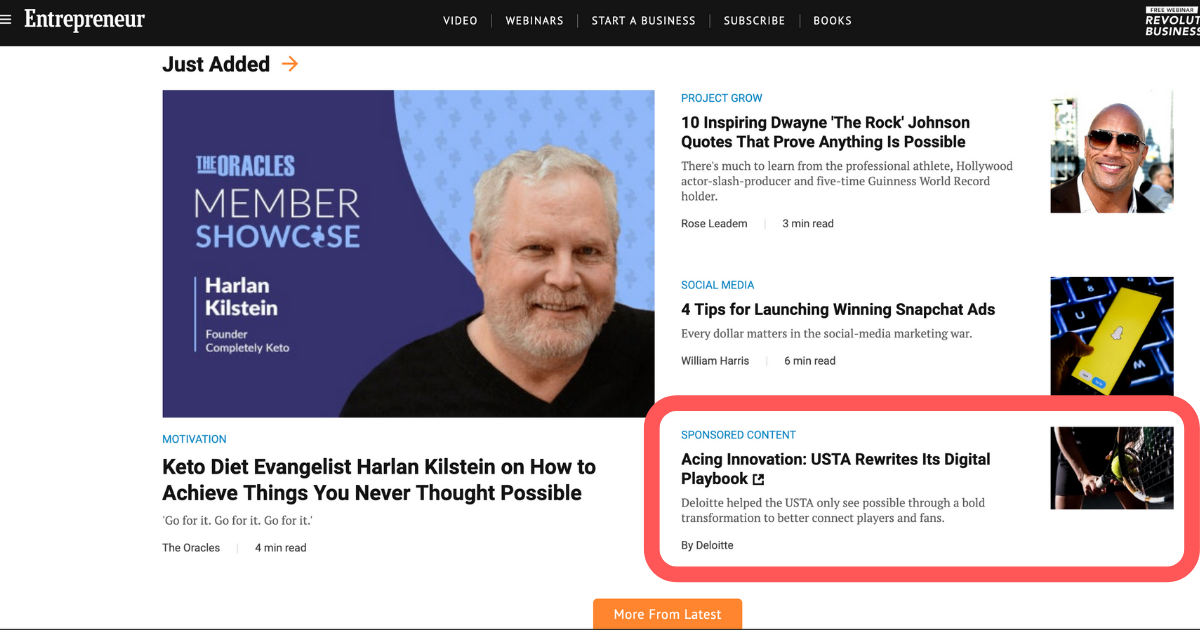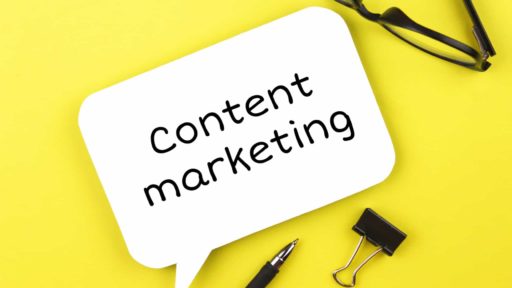Whether you’re a seasoned marketer, social media manager, or just starting out learning about digital marketing, you will likely have heard about content marketing. But these days, it seems that not everyone understands what native advertising is or what it involves.
Both these forms of digital marketing came about as a result of marketers needing to solve the issue of ‘banner blindness,’ where internet users were becoming annoyed with the continued use of blatant adverts, such as banner ads next to the organic content they were reading. So much so that they just started ignoring them. We called this behavior ‘banner blindness’.
From the ashes of regular, old-school ads rose the phoenixes of content marketing and native advertising. Two brothers who looked nothing alike but were brought into existence to achieve the same ultimate goal – to drive conversions!

More recently, two forms of native advertising: sponsored content and display ads, face much stiffer competition. Search engine algorithms are scouring the web billions of times per day for a relevant piece of content to match a user’s web search. Typically, they’ll see more results satisfying their search criteria from content marketing than from native advertising.
This could be in the form of many different types of content. The list goes on, from blog posts (or other editorial content), social media, videos, podcasts, infographics, presentations, webinars, and white papers.
Definitions of content marketing and native advertising
Before we get into this blog, let’s make sure we’re all on the same page by looking at the definitions from Google.
Content Marketing (noun: content marketing)
A type of marketing that involves the creation and sharing of online material (such as videos, blogs, and social media posts) that does not explicitly promote a brand but is intended to stimulate interest in its products or services.
“social media is an integral part of content marketing”
Native Advertising (noun: native advertising)
Material in an online publication which resembles the publication’s editorial content but is paid for by an advertiser and intended to promote the advertiser’s product.
“even when it comes to native advertising, savvy Internet users can tell ads from stories”
Bit of a burn by Google there, but ok!

In more detail
Native advertising is clearly marked as being a paid promotion. It has a shorter-term objective to drive a sale. You’ll find these in sidebars, social platforms, and in the body of posts. It’s often in the form of a display ad, advertorial, content recommendation widget, or featured posts on social media. They will always have to say: “sponsored post”, “paid advert”, “featured product…” you get the idea.

Content marketing is the polar opposite, it’s longer-term in its objective, subtler, and usually takes on a longer format. The intention is to educate, inform, provide value and keep on enticing the right audience to return, building trust with the brand. The end goal, of course, is a sale, or some form of conversion.
This blog post that you’re reading right now, for example, is content marketing. I’m providing information to a targeted audience about different ways they can do it, I’m not forcing a sale, and it’s never in danger of being blocked by ad blockers. At its core, this blog post has the intention to help educate and inform the right audience for Quuu Promote.
Native content should be seamless to be effective, but these days, they’re often jarring to the reading experience. In my opinion, this isn’t always because of how they appear on a site or app, but rather because you need to optimize native advertising. Not doing so means it can lack relevancy to the content around it and lack added value when you click through to the link.
We see a great deal more click-bait style headlines used for display ads that make them stand out as being blatant paid ads.
It is for this reason that with Quuu Promote, we don’t approve any content that has too many adverts or is overly promotional of any single entity. We made this decision based on years of feedback from our users on Quuu who didn’t appreciate sharing content with their followers that was littered with adverts and clearly pushing another person’s agenda.
How should you use native advertising?
I found another definition for native advertising with further instructions as to how you should aim to mix it into your content marketing campaigns with a particular focus on user experience.

So now we all understand the intention of a good native advert, but what absolutely must follow this native design is relevancy and value! Without that, I think people are just wasting their time! Nobody likes to be tricked, and content that is designed to make you click but doesn’t deliver on its promise will definitely damage your brand’s reputation.
As Neil Patel says: “If you feel like you can’t dedicate the time, energy, or resources to creating something of value to go along with your ad, you may want to stick to traditional advertising.” – Source
If you need something more, here’s a great case study showcasing successful examples of native advertising.
Pros and cons of native advertising?
| Pros | Cons |
| It’s relatively quick to produce. | It can be expensive to pay for sponsored placements. |
| It’s easy to target potential customers. | It can be off-putting to visitors to your site, and disrupts the reading experience. |
| Has an excellent CTR (click-through rate) on mobile. | Paid content is often considered to be biased and can be often ignored. |
| They avoid ad blockers. | Can be very bad for brand perception (depending on the individual). |
| If done right, it’s easy to track performance. | There’s a common perception now that native ads are not worth clicking through to as they’re rarely relevant. |
| The sales cycle is short from click to conversion. | |
| If people pay you for sponsored content then it’s a good way to earn extra revenue. | |
| If carefully chosen you could help your visitors find unexpected helpful content/products/services. | |
| Can be very good for brand awareness. |
Pros and cons of content marketing?
| Pros | Cons |
| It’s totally free if you create your own content in-house (other than the time of your employees to create it). | It’s time-consuming to produce high-quality content. |
| It’s generally easy to target people. | The sales cycle is long. It’s normally top-of-the-funnel marketing. |
| Avoids ad blockers because although the long game is selling, it’s not an ad. | Learning all that’s involved in content creation takes time and commitment. You can’t simply post and sit back. |
| It can super-charge your SEO – Google loves content! | |
| It provides a catalogue of resources for users/customers. | |
| It provides lots of opportunities for content repurposing. | |
| If done right it’s easy to track performance. | |
| You have endless opportunities to educate and provide value to your target audience. | |
| It’s amazing for building brand loyalty. | |
| Offers fantastic opportunities for engaging with your target audience. |
Which marketing tactic is better for me, content marketing or native advertising?
There is no barrier other than time and commitment to getting into content marketing, and the benefits of a good content marketing strategy are so great that I would recommend that it is a good fit for everyone to add into their digital marketing in 2023.
Native advertising campaigns, on the other hand, rely on the available budget to have your content strategically placed and therefore are not always possible for everyone. Whether it’s paying for a tweet to be promoted, an advertorial feature in a digital guide or journal, or even a simple display ad in a sidebar.
That being said, if you do have the budget to use both strategies this year, then if implemented correctly and the performance is regularly tracked and analyzed, you could have a powerful marketing combo at your disposal.

There’s no reason to only be in one camp or the other when it comes to your digital marketing, and there are myriad forms that dictate whether or not native advertising is right for you.
Some things to consider:
- Do you have click heat map data that gives you metrics into how your users browse your content? Do they tend to click multiple links in a list of available options, or are they picky?
- Do you have the kind of product or service that people can buy with minimal thinking required before committing?
- Is your target audience at all impulsive?
- Are they visually driven, or do they prefer reading about things in general?
- Do you have enough budget to experiment with it, and if it fails, then you won’t need to look down the back of the office sofa?
Useful content marketing and native advertising tools for 2023
Some content marketing tools that you may wish to check out are:
- Grammarly – Check your writing and grammar skills meet the grade.
- Quuu Promote – Have your content shared by hundreds of relevant people to their social media following.
- Google Docs – Google’s answer to Microsoft Word. Just as powerful, collaborative, free, and cloud-based.
- Clearscope – Optimize your content for SEO based on Google’s top-performing content at the time.
- MailChimp – Grow your email marketing list and distribute newly published blogs to your existing fans.
- UberSuggest – Research content topics for free and gain insights into content ideas and search volumes for chosen keywords.
- BuzzSumo – See which keywords and titles are currently performing well on Google and across social media!
Some native ad networks that you may wish to check out are:
How will your digital marketing strategy look in 2023?
I hope you’ve enjoyed reading this post and that if you weren’t fully aware of the differences between these two marketing tactics before, then you are now!
For the time being at Quuu, our content marketing efforts are 100% focused on upping our SEO performance. From 2015 until 2022, we’ve mostly used Quuu Promote to market ourselves. We’ve had minimal success with Facebook, Twitter and LinkedIn ads, so we’ve stuck to what we know.
I’m not ruling out using native advertising for Quuu in the future, but for the time being, we still feel that we’ve got a lot of untapped potential to fulfill within the realms of content marketing.
I wish you all the luck, and invite you to share your experiences below. Does content marketing work for you? Or do you have better results with native advertising?





